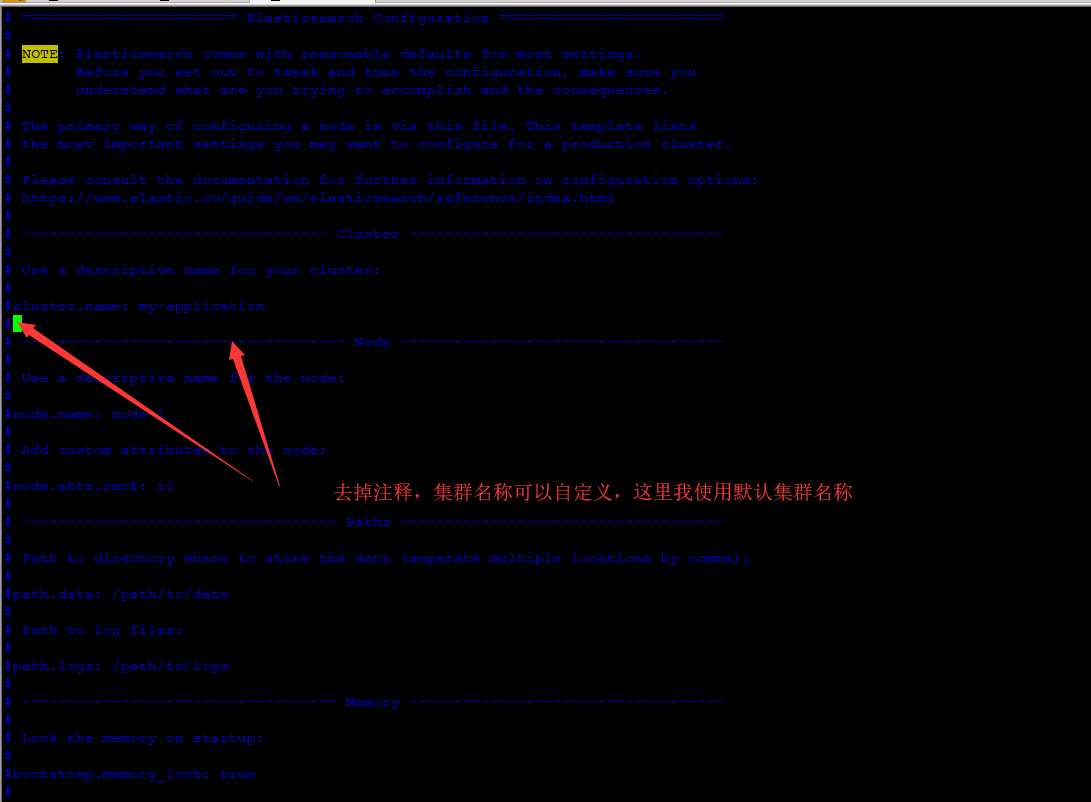标签:ext conf str long ddt number key prope create
一、在进行java操作elasticsearch之前,请确认好集群的名称及对应的ES节点ip和端口
1、查看ES的集群名称
#进入elasticsearch.yml配置文件
/opt/elasticsearch-6.4.3/config vim elasticsearch.yml

2、查询ip

二、根据文档id查询数据
/** * */ package com.cyb.test; import java.net.InetAddress; import java.net.UnknownHostException; import org.elasticsearch.action.get.GetResponse; import org.elasticsearch.client.transport.TransportClient; import org.elasticsearch.common.settings.Settings; import org.elasticsearch.common.transport.TransportAddress; import org.elasticsearch.transport.client.PreBuiltTransportClient; import org.junit.Test; /** * @Title: EsDemo.java * @Package:com.cyb.test * @Description: * @author:陈远波 * @date:2019年1月20日 * @version:V1.0 */ public class EsDemo { //从es中查询数据 @Test public void test1() throws UnknownHostException { //1、指定es集群 cluster.name 是固定的key值,my-application是ES集群的名称 Settings settings = Settings.builder().put("cluster.name", "my-application").build(); //2.创建访问ES服务器的客户端 TransportClient client = new PreBuiltTransportClient(settings) //获取es主机中节点的ip地址及端口号(以下是单个节点案例) .addTransportAddress(new TransportAddress(InetAddress.getByName("192.168.1.94"), 9300)); //实现数据查询(指定_id查询) 参数分别是 索引名,类型名 id GetResponse response = client.prepareGet("lib3","user","1").execute().actionGet(); //得到查询出的数据 System.out.println(response.getSourceAsString());//打印出json数据 client.close();//关闭客户端 } }
在kibana中查询id为1的结果为:

java控制台输出的结果为:

三、插入数据
1、在插入数据之前,需要使用kibana在es中建立索引和定义好字段等信息
PUT /index1 { "settings": { "number_of_shards": 5, "number_of_replicas": 0 }, "mappings": { "blog":{ "properties":{ "id":{ "type":"long" }, "title":{ "type":"text", "analyzer":"ik_max_word" }, "content":{ "type":"text", "analyzer":"ik_max_word" }, "postdate":{ "type":"date" }, "url":{ "type":"text" } } } } }
2、java实现添加
//插入数据 @Test public void test2() throws IOException { //1、指定es集群 cluster.name 是固定的key值,my-application是ES集群的名称 Settings settings = Settings.builder().put("cluster.name", "my-application").build(); //2.创建访问ES服务器的客户端 TransportClient client = new PreBuiltTransportClient(settings) //获取es主机中节点的ip地址及端口号(以下是单个节点案例) .addTransportAddress(new TransportAddress(InetAddress.getByName("192.168.1.94"), 9300)); //将数据转换成文档的格式(后期可以使用java对象,将数据转换成json对象就可以了) XContentBuilder doContentBuilder=XContentFactory.jsonBuilder() .startObject() .field("id", "1") //字段名 : 值 .field("title", "java设计模式之装饰模式") .field("content", "在不必改变原类文件和使用继承的情况下,动态地扩展一个对象的功能") .field("postdate", "2018-05-20") .field("url", "https://www.cnblogs.com/chenyuanbo/") .endObject(); //添加文档 index1:索引名 blog:类型 10:id IndexResponse response = client.prepareIndex("index1","blog","10") .setSource(doContentBuilder).get(); System.out.println(response.status()); //打印出CREATED 表示添加成功 }
三、java实现删除
//删除文档 @Test public void test3() throws UnknownHostException { Settings settings = Settings.builder().put("cluster.name", "my-application").build(); //2.创建访问ES服务器的客户端 TransportClient client = new PreBuiltTransportClient(settings) //获取es主机中节点的ip地址及端口号(以下是单个节点案例) .addTransportAddress(new TransportAddress(InetAddress.getByName("192.168.1.94"), 9300)); DeleteResponse response = client.prepareDelete("index1","blog","10").get(); System.out.println(response.status()); //控制台打印出OK代表删除成功 }
四、java实现修改数据
1、对指定字段进行修改
//修改数据(指定字段进行修改) @Test public void test4() throws IOException, InterruptedException, ExecutionException { Settings settings = Settings.builder().put("cluster.name", "my-application").build(); //2.创建访问ES服务器的客户端 TransportClient client = new PreBuiltTransportClient(settings) //获取es主机中节点的ip地址及端口号(以下是单个节点案例) .addTransportAddress(new TransportAddress(InetAddress.getByName("192.168.1.94"), 9300)); UpdateRequest request = new UpdateRequest(); request.index("index1") //索引名 .type("blog") //类型 .id("10")//id .doc( XContentFactory.jsonBuilder() .startObject() .field("title", "单例设计模式")//要修改的字段 及字段值 .endObject() ); UpdateResponse response= client.update(request).get(); System.out.println(response.status()); //控制台出现OK 代表更新成功 }
2、使用upsert修改
upsert修改用法:修改文章存在,执行修改,不存在则执行插入
//upsert 修改用法:修改文章存在,执行修改,不存在则执行插入 @Test public void test5() throws IOException, InterruptedException, ExecutionException { Settings settings = Settings.builder().put("cluster.name", "my-application").build(); //2.创建访问ES服务器的客户端 TransportClient client = new PreBuiltTransportClient(settings) //获取es主机中节点的ip地址及端口号(以下是单个节点案例) .addTransportAddress(new TransportAddress(InetAddress.getByName("192.168.1.94"), 9300)); IndexRequest request1 = new IndexRequest("index1","blog","8").source( XContentFactory.jsonBuilder() .startObject() .field("id", "2") //字段名 : 值 .field("title", "工厂模式") .field("content", "静态工厂,实例工厂") .field("postdate", "2018-05-20") .field("url", "https://www.cnblogs.com/chenyuanbo/") .endObject() ); UpdateRequest request2 = new UpdateRequest("index1","blog","8").doc( XContentFactory.jsonBuilder().startObject() .field("title", "设计模式") .endObject() ).upsert(request1); UpdateResponse response = client.update(request2).get(); System.out.println(response.status()); }
以上是java对elasticsearch的基本操作,下一篇博客本人将书写bulk的批量操作。对ES感兴趣的朋友可以加个关注,另转发请说明出处,本人的博客地址为:https://www.cnblogs.com/chenyuanbo/
技术在于交流!
java操作elasticsearch实现基本的增删改查操作
标签:ext conf str long ddt number key prope create
原文地址:https://www.cnblogs.com/chenyuanbo/p/10296809.html